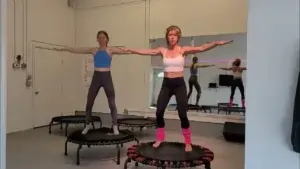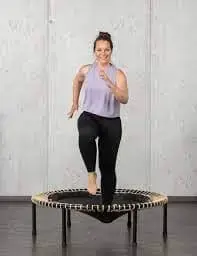14 Best Rebounding Exercises For Weight Loss
Introduction:
Rebounding exercises for weight loss typically involve a combination of different jumping movements, such as jogging, jumping jacks, and high knees. These exercises can be performed at varying intensities to suit different fitness levels.
Rebounding is a low-impact cardio exercise that involves jumping on a small trampoline, also known as a rebounder. It’s a fun and effective way to burn calories, improve cardiovascular health, and increase lymphatic drainage.
Among many other advantages, rebounding can help strengthen your bones, improve your endurance, and engage your leg muscles. This kind of workout is becoming more and more popular because it works your cardiovascular system without putting a lot of strain on your joints.
Strength and balance exercises can also be performed on a miniature trampoline. Standing on the trampoline for strength training improves core activation and total muscular stability because the mat is soft. On an unstable surface, your body must stabilize.
Rebounding’s minimal impact makes it possible to do it every day without putting undue pressure on joints. Beginners should begin with three sessions per week or less, though. In addition to providing comfort, this thoughtful approach helps individuals adjust to new muscle activation and balancing challenges.
The advantages of rebounding exercises:
- They have minimal impact
As you bounce, the soft trampoline surface and elastic cables support you, lowering your landing weight and easing joint strain. Rebounding is a workout that you can do well into old age because it can be both high-intensity and low-impact.
- Increases muscle strength
Jumping on a rebounder trampoline is good for your muscles. You use your lower body and core muscles, like your hamstrings, glutes, and abdominals, to help you maintain your balance when moving on an unstable surface.
- From head to toe, they get you moving
You can work your entire body by jumping on a trampoline. Since these muscles are most used to stabilize you when you jump on the trampoline, rebounding specifically works the glutes, hamstrings, and core.
- They can improve your mood
Trampoline jumping is a lot of fun in addition to being an excellent form of exercise. Movements that make us laugh and feel energetic should be a part of any workout. Endorphins, sometimes referred to as hormones that make you feel better, are then released, elevating your mood.
- They will burn calories
Rebounding may help in weight loss in part because it burns calories.
- Improves coordination and balance
Maintaining your balance when jumping on a rebounder trampoline also tests your ability to stay upright. Better balance may result from strengthening your stabilizing muscles as you adjust to the unstable surface. Mini trampoline exercises have been shown to improve the functional mobility and balance of older women. This will be especially helpful to those who are more likely to fall and get injuries as a result.
- Encourage cardiovascular fitness and health
Aerobic exercise is good for your heart. Cardiovascular health can be improved by these things. Additionally, it could help you increase your endurance and fitness for other exercises and activities.
Things to Consider Before Beginning Rebounding Exercise:
Different rebounders have different constructions. As a result, there are a few key considerations when buying a rebounder.
- Size
The jumping area is typically a little smaller, even though the majority of rebounders have a 40-inch diameter. Wider jumps are made possible by larger trampolines, but it’s vital to keep in mind that they will also require more room.
- Stress
Less bounce will come from a firmer selection, and too much bounce could cause you to jump too high. Certain options can be adjusted to allow you to discover your perfect spot.
- The type of bounce
There are spring and bungee versions of exercise trampolines. While spring choices may provide greater bounce, bungee solutions might be less taxing on the joints.
- Level of Noise
Even though a lot of alternatives are quiet, it’s still vital to take into account the rebounder’s total sound level, particularly if you have below neighbors or don’t live alone. Generally speaking, bungee choices are quieter than spring options.
Rebounding Exercises For Weight Loss:
High bounce
You probably picture a high bounce when you think about jumping on a trampoline. You can use it as a warm-up or cool-down for your body and it’s a natural jump up and down that helps you increase circulation and activate your lymphatic system. Additionally, it tones your lower body and core.
- Go ahead and use the trampoline to jump up and down.
- Maintain free-form motions and relax your body.
- Take your time breathing, landing with your upper body relaxed and your knees flexible.
- Then return to your neutral position.
- Then relax.

Ski
Since you’re moving with a smaller foundation, skis are excellent for a stability issue. It’s one of the hardest trampoline exercises since it requires you to squeeze your legs together while moving side to side, especially as you pick up speed. Additionally, your core, glutes, hamstrings, inner thighs, and obliques will be activated.
- To squeeze your legs together from your inner thighs to your ankles, go onto the trampoline.
- Beginning with side-to-side jumping, use your hip force to go from right to left on the trampoline.
- By swinging your arms along the sides of your body and using movement, you can move from one side to the other.
- Squeeze your obliques on either side to help with your landing while keeping your body low to the ground.
- Then return to your neutral position.
- Then relax.

Rebounder jogging
- With your feet hip-width apart, take an upright position in the middle of the rebounder trampoline.
- As though you were marching in place, raise one leg to your chest while using your abs.
- As you switch legs, raise each knee as high as it feels comfortable.
- Control your movements.
- Your arms should be raised as you extend your legs.
- Then return to your neutral position.
- Then relax.

Bouncing arm raises
A fantastic method to test your coordination and train your upper and lower body is with bouncing arm lifts.
- Your feet should be hip-width apart while you stand upright on the rebounder.
- Keep your arms by your sides while remaining your core engaged.
- Jump up and down the trampoline.
- Maintain a straight arm position.
- Lower your arms to your sides, then stand up straight once more.
- Repeat the arm movements while continuing to bounce.
- For a few seconds, keep going.
- Then return to your neutral position.
- Then relax.

Squats
Squats and other bodyweight exercises can also be performed on a rebounding trampoline. A rebounder’s uneven surface might use your body’s smaller muscles to help stabilize you.
- Your feet should be about hip-width apart in the standing position
- As you lower your hips toward the rebounder, contract your core.
- Be careful that your knees do not cross your ankles.
- Hold the squat position for five seconds.
- After that, push through your heels to stand again.
- Then return to your neutral position.
- Then relax.

Jumping Jack
Jumping jacks help you develop your ability to move side-to-side on your trampoline while also strengthening your core, glutes, hamstrings, abductors, adductors, and upper back.
- On the trampoline, start by bouncing your feet in and out, just like you would with a floor jumping jack.
- Instead of leaping up, press down onto the trampoline while keeping your weight in your heels and your knees flexible.
- Move your arms out to the sides, toward and away from your body, while keeping your legs together.
- Next, tighten your legs on the inside of your jack.
- Then return to your neutral position.
- Then relax.

Cross countries
You may also become familiar with trampoline activities with this cross-country workout. Consider this leaping motion as a means of promoting light footwork.
- Keep your feet hip-width apart while standing on the rebounder trampoline.
- Bounce lightly on each foot while you jog in place.
- Maintain your steps as low and rapid as you can.
- Keep going for a minimum of a few seconds.
- Increase the duration of this workout gradually to build endurance and strength.
- Then return to your neutral position.
- Then relax.
High knees
You can go to more challenging exercises like high knees after you’ve mastered running, jumping on a rebounder, and marching.
It requires coordination, footwork, and agility.
- The ideal distance between your legs when standing on the rebounder is hip-width.
- Using your arms and core, bring your right knee firmly to your chest.
- Reposition your right foot on the rebounder by bringing your left knee up to your chest and switching legs.
- Continue switching legs for a short while.
- Try to run as fast as you can and land on your heels.
- Then return to your neutral position.
- Then relax.
Jump squats
Plyometric exercises like the jump squat increase muscular strength, power, and cardiovascular fitness. Your joints are protected by the trampoline’s support as you land.
- Your feet should be on the rebounder.
- Next, tighten your glutes and core.
- Maintain your arms by your sides.
- To perform a squat, bend your knees, extend your arms, and sit back with your hips.
- Straighten your hips and knees and jump as high as you can by pushing through your heels.
- Power the jump with your arms.
- After bending your knees to cushion your landing, immediately start the cycle over by performing a full squat.
- Move quickly and powerfully with each repetition.
- Then return to your neutral position.
- Then relax.
Kick
In addition to being one of the most adjustable trampoline movements, kicks work your core, hamstrings, and glutes. As you become stronger at rebounding, you may perform them in any direction.
- To strengthen your knee use, stretch your leg and foot in front of you as you walk onto the trampoline by releasing your hamstrings.
- Focus on using your core to raise and lower your leg while releasing your hip flexor and quadriceps on the kicking side.
- For stability, keep applying pressure through your supporting side heel while you move and switch between sides.
- Then return to your neutral position.
- Then relax.
Scissors
With scissors, it’s more difficult to arrange your feet on the trampoline such that they land apart rather than next to one another. At the same time, they test your upper-body coordination, build your confidence in performing quick foot changes on the trampoline, and strengthen your core, glutes, hamstrings, and adductors.
- Position your hips aligned to each other and your feet slightly apart.
- As you bounce on the trampoline, place one foot forward and one behind to ensure that your feet are spread.
- As you keep your position narrow, begin switching between your front and back foot.
- As your legs move past one another, press down on the bottoms of your feet to activate your adductors or inner thighs.
- As you land, press down equally on both feet by keeping your weight evenly distributed between them.
- Then, let your arms swing freely.
- Then return to your neutral position.
- Then relax.
Twist
Twists cause opposition through your body and increase spinal rotation by activating your internal and external obliques, two side ab muscles. Strengthening your core muscles can be achieved with this type of ab exercise.
- Start by assuming an active posture on the trampoline, with your knees bent carefully and your feet somewhat wider than hip-width apart.
- Jump onto the trampoline and rotate your lower body to the left as soon as your feet touch the ground.
- Your obliques, or side abs, should feel activated.
- Keep your body straight and swing your left arm forward like a bowling ball.
- Move your right arm forward, rotate to the right, and repeat the motion once your feet touch down.
- It’s one repetition.
- Then return to your neutral position.
- Then relax.
Bounce down
This strengthens your hamstrings, glutes, and core while preparing your body for additional dynamic trampoline routines.
- Your feet should be somewhat broader than the distance apart when you stand on the trampoline.
- Choose a position that resembles a squat (but not your lowest squat) and start pushing your heels down into the rebounder repeatedly, much like you would if you were using your foot’s heel to press a button.
- By using your abdominal muscles to raise your knees toward your chest without leaping up and away from the rebounder, you may press harder into your heels while maintaining a low upper body.
- Let your arms swing from your shoulders as you bounce down, and relax your upper body.
- Then return to your neutral position.
- Then relax.
Twist bounce
A variant of the previous twist and bounce down exercises, the twist bounce is a great way to strengthen your glutes, calves, hips, back, and stomach.
- Position your feet hip-width apart on the trampoline.
- Then think of the little trampoline as a clock.
- To create a wide stance, leap your feet apart from three to nine o’clock.
- To go to six and twelve, rotate your body and legs to the right as you raise yourself, and then come back.
- Move your arms side to side in the opposite direction as you jump.
- Bend to the right for a few seconds, then twist to the left for a few seconds.
- Then return to your neutral position.
- Then relax.
Safety advice for rebounding:
As with any exercise, safety is crucial, so when performing rebounding exercises, be sure to pay attention to essential safety instructions.
After using a mini-trampoline for the first time, you can experience some lightheadedness or dizziness. You should still stop exercising if you feel lightheaded or faint, even if your body might simply need some time to get used to this new kind of exercise. Get in touch with your physician if these symptoms remain after multiple workouts.
- Pay attention to your body
If any of the trampoline exercises make you feel nauseous, dizzy, or in pain, stop.
- Be sure to pick your trampoline exercises wisely
Include rebounding activities that are suitable for your goals and degree of fitness. Avoid doing any flips, leaps, or inverted movements.
- Put your trampoline together correctly
Rebound trampolines are available online and at sporting goods stores. Make sure the trampoline has been put together correctly and placed on a level, secure area.
- Think about utilizing a safety bar
A safety bar is often included with rebound trampolines. It will be helpful for newcomers and anyone who might need greater stability. If you wear glasses when rebounding, you can also use a sports strap.
- Before each use, check your rebound trampoline
Before jumping on a rebounder, always make sure the legs are locked in place. Additionally, make sure you have enough space to jump above and to your sides and that nothing is underneath it.
What precautions should be taken when exercising?
- When working out, refrain from using strong or forceful motions.
- To prevent falls during your workout, focus and keep your eyes on yourself.
- Dress comfortably in loose-fitting garments to improve the effectiveness of your workout and to allow for easy mobility.
- Avoid wearing anything too tight or fashionable.
- Make sure you drink enough water before, during, and following your session to stay hydrated.
- Try to have proper posture when working out.
- Start slowly and as your strength increases, increase the amount of sets and repetitions.
- Breathe deeply and continuously to get maximum benefit out of your workout.
When do you stop exercising?
- High fever
- You feel ill.
- If exercise begins to hurt, it should be stopped.
- Headache
Rebounding risks:
- Although rebounding is typically safe for most individuals, not everyone is a good fit for it.
- To avoid nausea or dizziness, rebounding should be avoided by anyone who has balance disorders, inner ear abnormalities, or balance issues.
- Also, you should always consult a doctor before adding bouncing to your routine because it can be stressful to the pelvic floor if you are pregnant or have just given birth.
- To prevent more injuries, people with joint replacements or injuries to their backs or necks should also obtain permission from their physician or physical therapist.
Summary:
The term “rebounding” describes working out while jumping on a miniature trampoline.
In addition to protecting your bones and joints, low-impact activity can develop your muscles, increase your heart health, and improve your balance.
Because it can cross-train your body from an aerobic workout to help in muscle gain, a rebounder is incredibly beneficial. As your level of fitness increases, you will burn more calories in a targeted way. When it comes to weight loss, cardio exercises on a rebounder are the best option.
Furthermore, trampoline activities are simple enough for people of all skill levels and fitness levels to perform. To achieve your goal of losing weight, keep in mind that regularity is essential. The majority of the time, try to get in at least 30 minutes of rebounding exercise each day. Rebounding can be combined with other workouts, like yoga and strength training, to create a comprehensive exercise regimen.
FAQ:
Is utilizing a rebounder to reduce weight possible?
Cardio exercises performed on a rebounder are ideal if you’re trying to lose weight through exercise. It’s not all about leaping up and down all the time when working out on a rebounder. There are easy activities you may use to improve your cardio and help you attain your goals.
How much time should be dedicated to rebounding each day, on average?
You rebound for ten minutes or more every day. Gradually extend your bounce time to 40 to 50 sixty seconds for a more efficient workout. Don’t forget to hydrate well and take breaks.
Is rebounding preferable to walking?
The impact of rebounding on soft tissue and joints is far lower than that of other activities. In contrast to walking or running, when pressure is mostly applied to the ankles, bouncing distributes pressure more evenly throughout the body.
How long does it take for me to see benefits from my rebound?
A rebounding exercise routine should result in weight loss within 12 to 20 weeks. But remember, the programs mentioned above weren’t simple. The participants engaged in many weekly workouts, with some sessions lasting more than an hour.
Is it possible to lose abdominal fat via rebounding?
Rebounding is a fantastic way to burn calories since it combines strength training with aerobic exercise. A moderate rebounder workout can burn 200–400 calories in 30 minutes. This adds to the calorie deficit needed to reduce body weight, particularly visceral fat.
Are your legs toned by rebounding exercise?
Bouncing engages every portion of your body naturally, unlike many exercises that need deliberate effort to target particular muscles.
How long is the ideal recovery period for weight loss?
Just ten minutes a day on a rebounder may be more beneficial for weight loss than thirty minutes at the gym or forcing yourself to perform a workout you don’t enjoy.
What is rebounding as a workout type?
A rebounder is a little trampoline used for low-impact aerobic exercises. It incorporates a variety of exercises, from very low-intensity to more intense, high-energy workouts, like leaping, skipping, and jogging in place.
What advantages does rebounding offer?
Improve the health of your heart
Make your muscles stronger.
Become more coordinated
Decrease tension
Is it safe for everyone to rebound?
For most people, rebounding is generally safe. Before beginning any new fitness regimen, it is crucial to consult your physician, particularly if you have any medical conditions.
References:
- A. Breitowich (2024, Sept. 3). Exercises for rebounding: 10 exercises to attempt, along with the advantages and disadvantages of this type of exercise. health of women. A62041510/best-rebounding-workouts/ https://www.womenshealthmag.com/uk/fitness/fat-loss
- On April 8, 2023, Ningthoujam, N. To stay in shape and lose weight, become a trampoline queen! Health shots. https://www.healthshots.com/fitness/weight-loss/be-a-trampoline-queen-to-keep-fit-and-lose-body-weight/
- On June 13, 2019, Marcin, A. How to Begin and Why You Should Try Rebounding. Health Line. Rebounding #safety-tips https://www.healthline.com/health/exercise-fitness
- L. Muinos (2024, Dec. 3). 2024’s Top 8 Exercise Trampolines: A Test and Review. Wellness. Exercise trampoline: https://www.health.com/fitness/fitness-gear
- T. Lampa (2024, Jan. 29). Everything You Should Know About Exercises Using Trampolines. Good housekeeping. The following is a list of trampoline workout exercises: https://www.goodhousekeeping.com/health/fitness/a46305953/
- Image 1, On December 22, 2023, Cscs, R. M. B. C. Is It True That Trampolining Aids in Detoxification? Form. Do-trampolines-detox-body-8400506 via Shape.com
- Image 2, On February 27, 2022, McGlashan, L., and McGlashan, L. Whole-Body Trampoline Exercise. Oxygen Mag. Female Exercises: Whole Body Workouts: Whole Body Trampoline Workout https://www.oxygenmag.com/
- Image 3, Lally, Ray. on February 14, 2016. Running on a trampoline to reduce joint stress [Video]. On YouTube. YouTube: https://www.youtube.com/watch?v=hvZsrTSJlrc and
- Image 4, Extreme Rebounding. February 28, 2022. A five-minute arm workout on a little trampoline, sometimes known as a rebounder [Video]. YouTube. @HnHGSm0VXV8 https://www.youtube.com/watch?
- Image 5, Dr. Axe, “Trampoline Workout: Benefits of Rebounding Exercises,” October 23, 2024. Axe, Dr. Trampoline workout: https://draxe.com/fitness
- Image 6, Jumping jacks on a rebounder. Skimble.com, n.d. How to perform jumping jacks on a rebounder: https://www.skimble.com/exercises/36031



